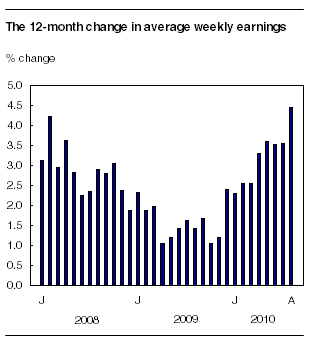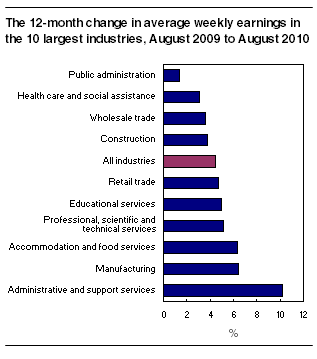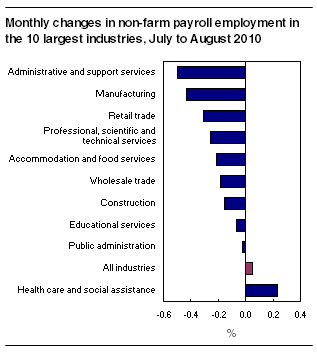Common menu bar links
Payroll employment, earnings and hours
Archived Content
Information identified as archived is provided for reference, research or recordkeeping purposes. It is not subject to the Government of Canada Web Standards and has not been altered or updated since it was archived. Please "contact us" to request a format other than those available.
Related subjects
Between August 2009 and August 2010, the average weekly earnings of non-farm payroll employees rose 4.4% to $860.67. The last time earnings growth exceeded 4.0% was in February 2008.
In recent months, the pace of growth in earnings has increased. August marked the fifth consecutive month for which the year-over-year increase was above 3.0%. In contrast, year-over-year growth was below 2.0% for most of 2009.
Average weekly earnings increased in all provinces from August 2009 to August 2010. Growth was above the national average in Alberta (+7.5%), Newfoundland and Labrador (+6.2%), Saskatchewan (+6.0%) and Ontario (+4.7%). New Brunswick (+0.6%) had the smallest year-over-year earnings growth.

Note to readers
The Survey of Employment, Payrolls and Hours (SEPH) is a business census of non-farm payroll employees. Its key objective is to provide a monthly portrait of the level of earnings, the number of jobs and hours worked by detailed industry at the national, provincial and territorial level.
Statistics Canada also produces employment estimates from its monthly Labour Force Survey (LFS). The LFS is a household survey whose main objective is to divide the working-age population into three mutually exclusive classifications: the employed (including the self-employed), unemployed and not in the labour force. This survey is the official source for the unemployment rate and collects data on the socio-demographic characteristics of all those in the labour market.
Unless otherwise stated, this release presents seasonally adjusted data, which facilitates comparisons by removing the effects of seasonal variations.
All earnings data include overtime pay and exclude businesses which could not be classified to a North American Industrial Classification System code.
Average weekly earnings are derived by dividing total weekly earnings by the number of employees.
Changes in average earnings can be influenced by a number of factors. Changes in the level of earnings, the number of payroll employees, and the number of hours worked can have an impact. Other factors could include compositional changes over time, such as changes in the proportions of full-time and part-time work; proportions of casual, senior and junior employees; the occupational distribution within and across industries; and in the distribution of employment between industries. Such effects may apply differently within different provinces and territories, and over time.
Because earnings can be influenced by any number of these factors, it is sometimes the case where earnings are moving in one direction and payroll employment is going the opposite direction (either at the aggregate level, by sector or industry). For example, there could be a year-over-year (or month-over-month) decline in employment, and at the same time, wages are increasing. The wage increase could be, for example, due to more hours worked by those currently employed; or a situation where the composition of the workforce changes as employers in certain industries may let go lower paid workers.
Average weekly earnings by industry
Among Canada's largest industrial sectors, growth in average weekly earnings from August 2009 to August 2010 was at or above the national average of 4.4% in administrative and support services (+10.2%), manufacturing (+6.5%), accommodation and food services (+6.4%), professional, scientific and technical services (+5.1%), educational services (+4.9%) and retail trade (+4.7%).
The administrative and support services sector, with the highest year-over-year average weekly earnings growth of the 10 largest sectors, had the greatest increases within the investigative and security services and employment services industries.

Solid average weekly earnings growth in transportation
The transportation and warehousing sector has had a notable shift in earnings growth in 2010, which followed steady declines throughout 2009. From January 2009 to January 2010, average weekly earnings fell from $900.60 to $839.67. Since then, earnings have risen by 7.2% to $900.03. Within this sector, the reversal from declining to increasing weekly earnings over the period was most notable in postal service, urban transit systems, support activities for road transportation and generalized freight trucking.
The transportation and warehousing sector had just under 670,000 employees in August, making it the 12th largest of 20 sectors in terms of payroll employment. Since January 2009, the number of jobs in this sector has declined by 3.4%. The earnings shifts are therefore not solely due to changes in the level of employment, but also to changes in average weekly hours worked, the level of earnings, and compositional changes within the sector (see Note to readers).
Earnings and employment in mining and related support activities up since August 2009
Average weekly earnings in the mining, oil and gas extraction sector were $1,538.75 in August 2009. Since then, earnings have risen by 17.1% to $1,801.18.
Payroll employment in mining, oil and gas extraction sector was 172,300 in August 2009. Although it dropped slightly over the following few months, it has steadily increased since to reach 189,800 in August (+10.2%).
The vast majority of growth in both earnings and payroll employment in this sector since August 2009 has been in three industries. Employment was up 20.3% in support activities for mining and oil and gas extraction, while earnings rose 24.0%. In mining and quarrying, employment was up 8.8% and earnings rose 8.9%. Payroll employment was down 2.1% in oil and gas extraction and average weekly earnings increased by 22.6%.
Non-farm payroll employment by industry
In August, non-farm payroll employment was up 0.1% (+9,300) from the month before. Since August 2009, the number of payroll employees has increased by 1.7% (+243,700).
Employment in health care and social assistance increased by 0.2% (+3,700) in August. This sector has expanded by 2.6% (+41,700) since August 2009.

In administrative and support services, payroll employment declined by 0.5% (-3,700) in August. Job declines were all in investigation and security services. Compared with one year earlier, however, employment in administrative and support services has increased by 2.4% (+17,000).
The number of people on payrolls in manufacturing declined by 0.4% (-6,400) in August. Employment in this sector has been relatively flat since August 2009 (+0.3%).
In August, the number of jobs in accommodation and food services decreased by 0.2% (-2,300), mainly in food services. This decline brings the number of payroll jobs in this sector to a level similar to that of August 2009.
There has been little change in construction payroll employment since April of this year. However, the number of jobs in this sector has increased by 4.1% (+32,100) since August 2009.
Hours worked and average hours worked by hourly and salaried employees
Total hours worked by hourly and salaried employees declined by 0.2% in August, the second time it has fallen in the past eight months. Average weekly hours worked by hourly and salaried employees was 32.9 hours, unchanged from the previous month and at the same level as 12 months earlier.
Available on CANSIM: tables 281-0023 to 281-0039 and 281-0041 to 281-0046.
Definitions, data sources and methods: survey number 2612.
Detailed industry data, data by size of enterprise based on employment, and other labour market indicators will be available soon in the monthly publication Employment, Earnings and Hours (72-002-X, free).
Data on payroll employment, earnings and hours for September will be released on November 25.
For more information, or to order data, contact Client Services (toll-free 1-866-873-8788; 613-951-4090; labour@statcan.gc.ca). To enquire about revisions, concepts, methods or data quality of this release, contact Jeannine Usalcas (613-951-4720), Labour Statistics Division.
Table 1
| Industry Group (North American Industry Classification System) | August 2009 | July 2010r | August 2010p | July to August 2010 | August 2009 to August 2010 |
|---|---|---|---|---|---|
| Seasonally adjusted | |||||
| $ current | % change | ||||
| Industrial aggregate | 824.10 | 852.99 | 860.67 | 0.9 | 4.4 |
| Forestry, logging and support | 879.35 | 888.29 | 971.18 | 9.3 | 10.4 |
| Mining and quarrying, and oil and gas extraction | 1,538.75 | 1,742.51 | 1,801.18 | 3.4 | 17.1 |
| Utilities | 1,538.41 | 1,576.84 | 1,516.34 | -3.8 | -1.4 |
| Construction | 1,032.11 | 1,063.05 | 1,071.11 | 0.8 | 3.8 |
| Manufacturing | 917.57 | 965.15 | 976.87 | 1.2 | 6.5 |
| Wholesale trade | 988.98 | 1,030.49 | 1,024.36 | -0.6 | 3.6 |
| Retail trade | 479.17 | 497.52 | 501.83 | 0.9 | 4.7 |
| Transportation and warehousing | 861.10 | 891.73 | 900.03 | 0.9 | 4.5 |
| Information and cultural industries | 1,099.24 | 1,059.59 | 1,099.82 | 3.8 | 0.1 |
| Finance and insurance | 1,060.20 | 1,038.11 | 1,050.02 | 1.1 | -1.0 |
| Real estate and rental and leasing | 748.59 | 809.37 | 784.48 | -3.1 | 4.8 |
| Professional, scientific and technical services | 1,113.77 | 1,159.03 | 1,170.77 | 1.0 | 5.1 |
| Management of companies and enterprises | 1,153.61 | 1,143.16 | 1,105.24 | -3.3 | -4.2 |
| Administrative and support, waste management and remediation services | 659.75 | 730.87 | 726.79 | -0.6 | 10.2 |
| Educational services | 901.84 | 939.92 | 946.30 | 0.7 | 4.9 |
| Health care and social assistance | 767.86 | 782.38 | 791.60 | 1.2 | 3.1 |
| Arts, entertainment and recreation | 544.71 | 551.04 | 561.64 | 1.9 | 3.1 |
| Accommodation and food services | 339.38 | 360.68 | 360.98 | 0.1 | 6.4 |
| Other services (excluding public administration) | 672.87 | 705.21 | 670.01 | -5.0 | -0.4 |
| Public administration | 1,083.74 | 1,089.89 | 1,098.91 | 0.8 | 1.4 |
| Provinces and territories | |||||
| Newfoundland and Labrador | 786.08 | 825.77 | 834.79 | 1.1 | 6.2 |
| Prince Edward Island | 691.94 | 696.00 | 700.78 | 0.7 | 1.3 |
| Nova Scotia | 730.52 | 763.96 | 759.68 | -0.6 | 4.0 |
| New Brunswick | 751.43 | 754.27 | 756.29 | 0.3 | 0.6 |
| Quebec | 761.29 | 784.84 | 783.25 | -0.2 | 2.9 |
| Ontario | 849.88 | 883.10 | 889.59 | 0.7 | 4.7 |
| Manitoba | 775.78 | 789.06 | 790.79 | 0.2 | 1.9 |
| Saskatchewan | 804.60 | 846.51 | 852.99 | 0.8 | 6.0 |
| Alberta | 934.39 | 985.81 | 1,004.11 | 1.9 | 7.5 |
| British Columbia | 796.27 | 826.26 | 825.39 | -0.1 | 3.7 |
| Yukon | 899.88 | 905.31 | 919.83 | 1.6 | 2.2 |
| Northwest Territories¹ | 1,156.16 | 1,218.70 | 1,226.96 | 0.7 | 6.1 |
| Nunavut¹ | 875.45 | 898.64 | 867.04 | -3.5 | -1.0 |
Table 2
| Industry Group (North American Industry Classification System) | December 2009 | August 2009 | July 2010r | August 2010p | July to August 2010 | August 2009 to August 2010 | December 2009 to August 2010 |
|---|---|---|---|---|---|---|---|
| Seasonally adjusted | |||||||
| thousands | % change | ||||||
| Industrial aggregate | 14,532.4 | 14,475.4 | 14,709.8 | 14,719.0 | 0.1 | 1.7 | 1.3 |
| Forestry, logging and support | 39.1 | 38.8 | 39.5 | 39.0 | -1.3 | 0.5 | -0.3 |
| Mining and quarrying, and oil and gas extraction | 173.4 | 172.3 | 188.6 | 189.8 | 0.6 | 10.2 | 9.5 |
| Utilities | 117.5 | 116.2 | 118.7 | 118.2 | -0.4 | 1.7 | 0.6 |
| Construction | 805.5 | 787.9 | 821.3 | 820.0 | -0.2 | 4.1 | 1.8 |
| Manufacturing | 1,447.3 | 1,453.8 | 1,465.2 | 1,458.8 | -0.4 | 0.3 | 0.8 |
| Wholesale trade | 723.0 | 724.6 | 729.1 | 727.8 | -0.2 | 0.4 | 0.7 |
| Retail trade | 1,859.9 | 1,854.0 | 1,853.5 | 1,847.8 | -0.3 | -0.3 | -0.7 |
| Transportation and warehousing | 669.7 | 669.1 | 668.5 | 667.7 | -0.1 | -0.2 | -0.3 |
| Information and cultural industries | 313.4 | 317.0 | 310.4 | 310.4 | 0.0 | -2.1 | -1.0 |
| Finance and insurance | 682.6 | 672.3 | 694.1 | 692.1 | -0.3 | 2.9 | 1.4 |
| Real estate and rental and leasing | 245.2 | 240.1 | 240.6 | 238.5 | -0.9 | -0.7 | -2.7 |
| Professional, scientific and technical services | 740.2 | 733.8 | 752.7 | 750.8 | -0.3 | 2.3 | 1.4 |
| Management of companies and enterprises | 117.9 | 112.8 | 107.5 | 108.5 | 0.9 | -3.8 | -8.0 |
| Administrative and support, waste management and remediation services | 719.2 | 712.4 | 733.1 | 729.4 | -0.5 | 2.4 | 1.4 |
| Educational services | 1,161.9 | 1,139.9 | 1,173.3 | 1,172.6 | -0.1 | 2.9 | 0.9 |
| Health care and social assistance | 1,606.5 | 1,579.7 | 1,617.7 | 1,621.4 | 0.2 | 2.6 | 0.9 |
| Arts, entertainment and recreation | 248.8 | 250.7 | 247.1 | 247.4 | 0.1 | -1.3 | -0.6 |
| Accommodation and food services | 1,068.5 | 1,060.1 | 1,064.8 | 1,062.5 | -0.2 | 0.2 | -0.6 |
| Other services (excluding public administration) | 506.2 | 505.1 | 506.4 | 504.5 | -0.4 | -0.1 | -0.3 |
| Public administration | 1,054.7 | 1,046.3 | 1,045.8 | 1,045.5 | 0.0 | -0.1 | -0.9 |
| Provinces and territories | |||||||
| Newfoundland and Labrador | 193.8 | 190.3 | 197.2 | 196.5 | -0.4 | 3.3 | 1.4 |
| Prince Edward Island | 63.6 | 63.9 | 65.3 | 64.4 | -1.4 | 0.8 | 1.3 |
| Nova Scotia | 395.6 | 391.8 | 403.3 | 402.9 | -0.1 | 2.8 | 1.8 |
| New Brunswick | 314.4 | 308.6 | 324.8 | 320.9 | -1.2 | 4.0 | 2.1 |
| Quebec | 3,360.1 | 3,329.2 | 3,369.7 | 3,369.2 | 0.0 | 1.2 | 0.3 |
| Ontario | 5,576.6 | 5,547.5 | 5,654.1 | 5,649.1 | -0.1 | 1.8 | 1.3 |
| Manitoba | 557.4 | 556.6 | 558.4 | 557.8 | -0.1 | 0.2 | 0.1 |
| Saskatchewan | 438.8 | 436.4 | 441.3 | 441.2 | 0.0 | 1.1 | 0.5 |
| Alberta | 1,718.3 | 1,700.6 | 1,749.7 | 1,749.2 | 0.0 | 2.9 | 1.8 |
| British Columbia | 1,876.8 | 1,881.2 | 1,896.0 | 1,893.0 | -0.2 | 0.6 | 0.9 |
| Yukon | 20.1 | 18.9 | 19.4 | 19.7 | 1.5 | 4.2 | -2.0 |
| Northwest Territories¹ | 26.8 | 27.1 | 28.2 | 28.1 | -0.4 | 3.7 | 4.9 |
| Nunavut¹ | 10.2 | 10.4 | 11.0 | 11.2 | 1.8 | 7.7 | 9.8 |

